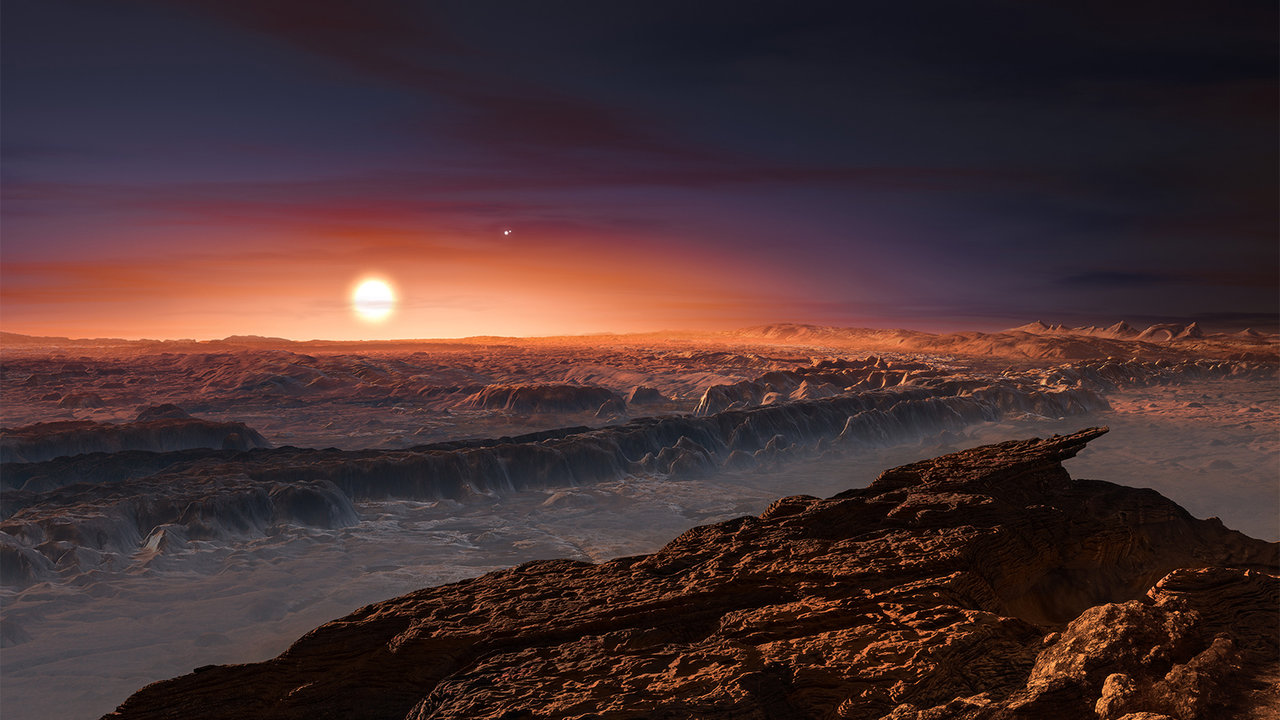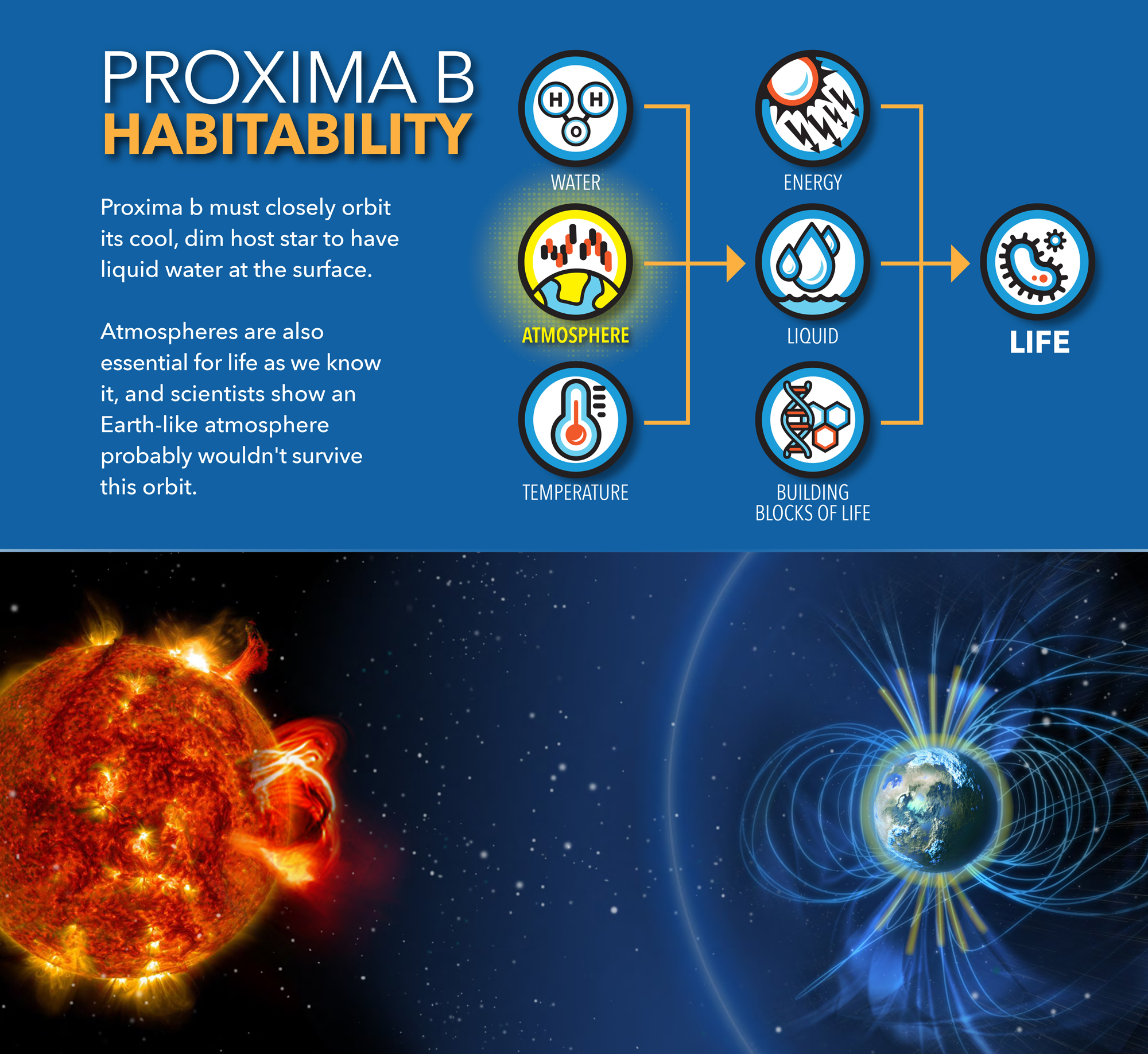Nearby Planet Proxima b's Atmosphere Was Likely Stripped Long Ago

The nearby alien planet Proxima b may have lost the ability to support life long ago, a new study suggests.
If Earth had formed where Proxima b orbits — quite close to a red dwarf star — our planet's atmosphere would likely have been stripped away by intense stellar radiation fairly quickly, the study found.
"Things can get interesting if an exoplanet holds on to its atmosphere, but Proxima b's atmospheric loss rates here are so high that habitability is implausible," co-author Jeremy Drake, an astrophysicist at the Harvard-Smithsonian Center for Astrophysics, said in a statement. "This questions the habitability of planets around such red dwarfs in general." [Proxima b: Closest Earth-Like Planet Discovery in Pictures]
Stripping the atmosphere
Proxima b circles the red dwarf Proxima Centauri, which lies just 4.2 light-years from the sun. The roughly Earth-size exoplanet completes one lap around its host star once every 11 Earth days. But, because Proxima Centauri is much dimmer than the sun, this tight orbit puts Proxima b within the habitable zone — the region where liquid water could exist on a planet's surface.
This proximity also puts the planet in danger, however. Red dwarfs tend to be quite active, especially in their youths. Charged particles pour out from these stars into space, and the closer a planet orbits to such a star, the more intensely it gets hit by damaging radiation.
High-energy UV light can knock electrons off molecules in a planet's atmosphere, producing charged particles (also known as ions). Some of these newly liberated electrons can be energetic enough to escape the planet's gravity, pulling particles of the opposite charge with them into space.
This atmosphere-stripping stellar activity is one reason many scientists argue that most planets around red dwarfs are not habitable. Because red dwarfs make up roughly three-quarters of the stars in the Milky Way, most of the galaxy's rocky planets may receive too much radiation for life to evolve.
Get the Space.com Newsletter
Breaking space news, the latest updates on rocket launches, skywatching events and more!
Planets can have a variety of shields against radiation. One possibility is a thick atmosphere, which can absorb the bulk of radiation hitting a planet. Another is a magnetic field, which can funnel charged particles away from the planet. But magnetic fields aren't always helpful.
"The magnetic poles of a planet can be connected to the stellar wind, which provides a pathway for the upper, ionized region of the atmosphere to escape," said Katherine Garcia-Sage, lead author of the new study and a space scientist at NASA's Goddard Space Flight Center in Greenbelt, Maryland.
"Energy from the stellar wind is also redirected to the magnetic poles, providing extra energy for escape at these same regions where ions and electrons are able to leave the planet and enter interplanetary space," told Space.com via email.
So, the same magnetic field that shields a planet can also help funnel away part of its atmosphere. [Alien World 'Proxima b' Around Nearest Star Could Be Earth-Like (Video)]

How would Earth fare?
To investigate what might be happening with Proxima b, Garcia-Sage and her colleagues did some computer modeling. Their models put an Earth twin — an Earth-size world with an Earth-like magnetic field — at Proxima b's spot and then buffeted the planet with the appropriate radiation (levels of which were determined using nearly 40 years of observations of Proxima Centauri).
"This was a simple calculation based on average activity from the host star," Garcia-Sage said in the same statement. "It doesn't consider variations like extreme heating in the star's atmosphere or violent stellar disturbances to the exoplanet's magnetic field — things we'd expect to provide even more ionizing radiation and atmospheric escape."
Despite the relatively conservative radiation dose, the modeled planet didn't fare well, the researchers found. Assuming high atmospheric temperatures and a completely open magnetic field, Proxima b could lose an Earth-equivalent atmosphere in only 100 million years, an eye-blink in the 4-billion-year lifetime of the planet, the researchers said. Even with the lowest temperatures and a closed magnetic field, the atmosphere would be stripped in 2 billion years.
Of course, these results assume an Earth-like magnetic field. A stronger or weaker magnetic field could produce different timescales, the scientists said.
"It is not immediately obvious which quantities contribute to a planetary magnetic field and to its strength," said Chuanfei Dong, a researcher at Princeton University. Dong, who was not involved in the project, studies exoplanet atmospheres.
Candidate contributors include a planet's radius, conductivity, density and core rotation rate, Dong said, and none of these quantities are known for Proxima b. Because of how the planet was detected, scientists have direct measurements of its mass but not its radius. That means they cannot directly calculate Proxima b's density, which would yield insights about the planet's core. Instead, researchers rely on previous studies that link a planet's mass with its radius.
"The radius of the planet can affect the radius of the electrically conducting fluid core, so it can affect the development and strength of its magnetic field," Dong told Space.com.
The distance between a planet and its star, and the time the planet takes to orbit, can also play important roles in determining the magnetic field strength, Dong said. That's due in part to the phenomenon called tidal locking, in which one side of a world permanently faces its star — a common feature of tightly orbiting worlds such as those in the habitable zones of red dwarfs.
Though the new results — which were published last month in The Astrophysical Journal Letters — don't bode well for the prospect of life on Proxima b, not all hope is lost, Dong said. Geological processes such as volcanic activity could help replenish a planet's atmosphere, he said.
Follow Nola Taylor Redd at @NolaTRedd, Facebook or Google+. Follow us at @Spacedotcom, Facebook or Google+. Originally published on Space.com .
Join our Space Forums to keep talking space on the latest missions, night sky and more! And if you have a news tip, correction or comment, let us know at: community@space.com.

Nola Taylor Tillman is a contributing writer for Space.com. She loves all things space and astronomy-related, and enjoys the opportunity to learn more. She has a Bachelor’s degree in English and Astrophysics from Agnes Scott college and served as an intern at Sky & Telescope magazine. In her free time, she homeschools her four children. Follow her on Twitter at @NolaTRedd









